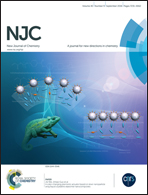Calix[4]arenes containing a ureido functionality on the lower rim as highly efficient receptors for anion recognition†
Abstract
The introduction of nosyl moieties onto the lower rim of the calix[4]arene skeleton led to the formation of compounds immobilised in cone conformations. Subsequent reduction of the nitro group and reaction with aryl isocyanates enabled the construction of new calixarene-based ligands for anion recognition. As proven by NMR and UV/vis titration experiments, diaryl urea moieties with electron-withdrawing substituents on both sides represent very efficient tools for the complexation of selected anions (AcO−, BzO−, H2PO4−) even in highly competitive solvents such as DMSO-d6.
![Graphical abstract: Calix[4]arenes containing a ureido functionality on the lower rim as highly efficient receptors for anion recognition](/en/Image/Get?imageInfo.ImageType=GA&imageInfo.ImageIdentifier.ManuscriptID=C6NJ01271J&imageInfo.ImageIdentifier.Year=2016)


 Please wait while we load your content...
Please wait while we load your content...